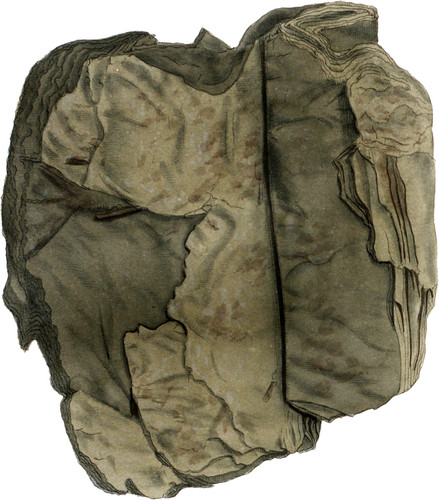 Enlarge
Enlarge
Exotic Mineralogy
Dysodile
- Syn.
- Dusodile. Cordier, Journal des Mines xxiii. 271. (Prem. sem. 1808.)
- Houille papyracé, Dysodile. Haüy Tabl. 71.
- Terre foliée Bitumineuse de Mélilli, vulg.
Dysodile was brought before the mineralogical world by Cordier who published an account in 1808, from specimens found at Mellili, near Syracuse, in Sicily, by Dominion, some ten years before. From this account it appears that it had been known by the inhabitants of the country where it occurs, a long while, and that they had worked the mine, but without profit, for there is only a thin stratum of it, and that between strata of secondary Limestone.
At first sight it might be taken for a mass of paper that had lain a number of years underground, and become of a dark colour, its structure is so perfectly foliated; the folia are brittle, easily separated from each other, and possess some elasticity even when dry; when heated in water they separate spontaneously, become more easily pliable, and are softened, but still elastic: they give no colour or taste to the water, but it acquires an earthy smell, and earthy particles separate from between the lamina, leaving them slightly translucent. It is highly inflammable, burning with a blight flame until a white ash is left of the same form, except a few blisters and equal to above a third of its weight: if the flame be extinguished a fœtid smoke is evolved of a different scent from cither that of Bitumen, Wood-Coal, or Bituminous Coal: I think it may be compared to a mixture of true Bitumen and Peat, free from the resinous smell sometimes found in Wood-Coal, but with a portion of animal matter: the scent was so intolerable to Cordier, who named it from it, that he says it is necessary to burn but a very small fragment to poison a room for an hour. The specific gravity, according to him, is 1.146. I understand a variety has been found in France, but I have not seen specimens.
The sports of nature are always admired, either from the great dissimilarity they bear to her usual productions, or from the resemblance things of perfectly different kinds exhibit in some characters to each other; thus the varieties of Asbestos, Dentrites, &c. are esteemed by every one: when nature produces any thing resembling the works of art, an additional gratification is felt, as if man were flattered by the imitation; thus, dysodile from its resemblance to paper or parchment, Soap-rock, leather-like Asbestos, graphic Granite, &c. are highly appreciated, even by persons wholly unacquainted with mineralogy. The present substance has its characters, as a mineral, so much disguised by the folded as well laminated structure, that it is difficult for those not conversant with the subject to believe it is one; a similar structure may, however, be traced through Gneiss, Slate, and other stratified rocks.
The liberality of G. B. Greenough, Esq. in presenting me with a handsome specimen for figuring, is one of the many proofs he has given of his zeal in promoting the distribution of knowledge. One specimen in this Gentleman’s collection has the impression of a small fish upon it: probably some remains of the animal substance might be traced by an attentive analysis, to be the cause of the difference between Dysodile and elastic Bitumen.
- * From δὺς male and οσμος olens.

